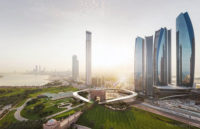Frank Gehry has been around Los Angeles long enough to remember when the legendary Garden of Allah hotel sat at the corner of Sunset Boulevard and Crescent Heights Boulevard, before there was a strip mall and a McDonald’s. Its Spanish Mediterranean bungalows lodged icons such as Greta Garbo, F. Scott Fitzgerald, and Humphrey Bogart.
“It was all white, the Garden of Allah. It was low rise, a lot of incense burning, and people in flowing gowns,” Gehry recalls.
He never set foot inside (“I was 17 or 18 years old!” he says), but the Pritzker Prize–winning architect is embarking on a new phase in the site’s history, with two young developers. They plan to create 8150 Sunset Boulevard, a proposed mixed-use development that will urbanistically anchor the east end of Sunset Strip.
“We’re hoping to create a sustainable, livable, walkable community,” says developer Tyler Siegel, cofounder of Townscape Partners.
Siegel and business partner John Irwin, along with investment advisor Angelo, Gordon & Co., acquired the property in 2012 after leaving the Related Companies to establish their own firm. They considered revamping the existing strip mall, but it became clear, given discussions with local stakeholders and the site’s storied past, that they needed to build something unique—both programmatically and architecturally.
“Not only does it form the border between Los Angeles proper and West Hollywood, but it forms the eastern gateway to the famous Sunset Strip,” says Siegel. “It’s also the first property you see when traveling from the valley of the Santa Monica Mountains to the L.A. basin.” It was no surprise, then, that Townscape tapped local firm Gehry Partners in March to take on the design.
Initial renderings of the $300 million development depict a cluster of five architecturally distinct buildings distributed across the 2.6- acre site around a central plaza. In total, the project will comprise 333,600 square feet, and have 249 residential units. One of the architects’ primary goals was to make the site as approachable as possible to invite the surrounding community in to shop, dine, or simply relax in the plaza.
“We broke down the forms to fit the scale of the street,” says firm partner, Anand Devarajan. “The orientation of the buildings provides transparency to make the site feel porous.”
Gehry adds, “The design, which is not finished, has a sculptural quality that will make it an interesting place to come to.”
Strolling down Sunset Boulevard, Angelenos will pass two three-story buildings made from glass with cross-laminated timber mullions. These buildings will house a mix of flagship stores, cafés, restaurants, and rooftop terraces. Retail, totaling 65,700 square feet, will be distributed throughout the bases of the buildings.
Two concrete-framed residential volumes— an 11-story tower on the east edge and a 15-story tower on the west—will bookend the site. The taller building, to contain condominiums, is the more flamboyant of the pair, featuring a sculptural top of billowing glass with views to the iconic Château Marmont across the boulevard. “The glass portion for the expensive condominiums needed to have an identity,” Gehry explains, “but you don’t want to make one section look like the poor brother or something, so we integrated the forms.” They hope to accomplish this by using similar architectural tropes throughout—large punched windows, cascading terraces, and white materials.
The site’s central volume will contain two three-story penthouses and is the most unique, with a white, tubular facade (the developers are thinking cut limestone) that is evocative of a sea anemone.
“When you are in a building—whether as an owner, a renter, or shopping—you look around and see different architectural elements,” says Siegel. “It’s almost eye-candy overload.”
The plan will be submitted for Environmental Impact Review this month, and, if all goes well, the developers hope to break ground late next year, or early 2017.
“We are excited to work with this young team, and it fits with our young team here,” says Gehry. “That’s nice to see, and it bodes well for the future of this office after I’ve decided to quit.”
He won’t be quitting any time soon: in August, the Los Angeles Times reported that Gehry is working pro bono with the nonprofit L.A. River Revitalization Corp. to create a master plan for the waterway. The architect is also working with the Related Companies to develop Grand Avenue in downtown L.A., and he will be the subject of an expansive traveling retrospective opening at Los Angeles County Museum of Art next month, in which the design for 8150 Sunset Boulevard will be included.
For Gehry, the success of the latter project will not be gauged by creating a millennial version of the Garden of Allah, or by crafting a new architectural icon—it will be measured by how future visitors and residents experience the place. “They should feel that they are part of L.A.,” Gehry says—“a part of L.A. that has a culture that comes with it.”





Post a comment to this article
Report Abusive Comment